 |
 |
 |
 |
 |
 |
 |
Home |
Philosophy |
About Chiro |
Questions |
Office |
 |
 |
 |
 |
 |
 |
 |
Home |
Philosophy |
About Chiro |
Questions |
Office |
 |
Dr. Eric D. Payne  Monday, Tuesday, Thursday & Friday 8am - 12 and 2 - 6pm ALSO Wednesday 9am - 12  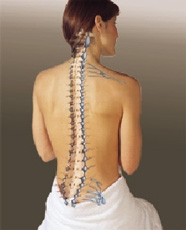 The Human Body The Human Body
The human body was fashioned together in an absolutely incredible way. We contain approximately 11 trillion cells, each one interconnected and intimately functioning together. The central nervous system (brain, brain stem, and spinal cord) is connected to the peripheral nervous system (spinal and peripheral nerves) and controls the way we move and function. Our skull protects our brain and most of our brain stem, and our spine provides protection to the spinal cord and spinal nerves. 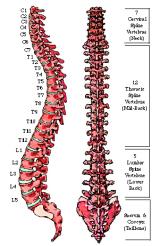 The spine is a column of small bones called “vertebrae”, that support the entire upper body. The column is grouped into three sections, the cervical (neck), thoracic (middle back), and lumbar (lower back) spine regions. The spine is a column of small bones called “vertebrae”, that support the entire upper body. The column is grouped into three sections, the cervical (neck), thoracic (middle back), and lumbar (lower back) spine regions.The neck consists of seven spinal bones created for movement. There are twelve vertebrae in the middle back connecting to the rib cage. The lumbar vertebrae are the five lowest and largest bones of the spinal column. Most of the body’s weight and stress falls on the lumbar vertebrae. Below the lumbar region is the sacrum, a triangular bony structure that connects with the pelvis at the sacroiliac joints. At the end of the sacrum are two to four tiny, partially fused vertebrae known as the coccyx or “tailbone.” 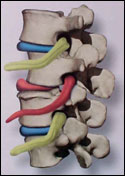 Vertebrae in the spinal column are separated from each other by small cushions of cartilage known as intervertebral discs . Vertebrae in the spinal column are separated from each other by small cushions of cartilage known as intervertebral discs .Inside each disc is a jelly-like substance called the nucleus pulposus, which is surrounded by fibrous structure called the annulus. The disc combines protein with approximately 80% water giving it an elastic quality and provides the spine with excellent shock absorption quality. The vertebrae and discs combine to create a space for each spinal nerve to exit from the spinal cord on its way to the body. Abnormal motion or positioning of the vertebrae (known as the vertebral subluxation complex or VSC) can compromise this space and create nerve irritations or nerve interference . The nerve will still go to the muscle or organ, however, the quality of the nerve transmission is affected. 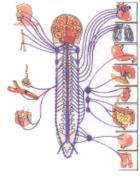 Think of a VSC as a dimmer switch on the lights. If the dimmer is turned down, the lights are still on, but at a decreased intensity. If it is turned up too high for too long, the light bulb may burn out prematurely. Therefore, the muscle or organ still receives the nerve impulse, however, it is altered . Think of a VSC as a dimmer switch on the lights. If the dimmer is turned down, the lights are still on, but at a decreased intensity. If it is turned up too high for too long, the light bulb may burn out prematurely. Therefore, the muscle or organ still receives the nerve impulse, however, it is altered .This helps to explain why when a VSC exists in the upper back region, an individual can experience the condition known as asthma (because the nerves in this region go to the small air tubes in our lungs called the bronchioles). 1.Loss of normal position (or alignment) of the vertebrae leads to restricted movement. 2.Abnormal positioning may lead to shortened muscle tissue with decreased strength and flexibility, as well as, scar tissue development. 3.Continued pressure on the nerve due to the subluxation, may lead to numbness or tingling in the area in which the nerve travels. 4.Swelling or inflammation may develop in the disc, joints, or surrounding tissues. 5.Degenerative Joint Disease (known as “DJD” or osteoarthritis”) may occur in the affected area leading to the development of bone spurs. 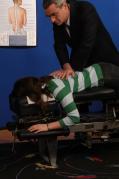 The passion of the Doctor of Chiropractic is to promote proper neuromusculoskeletal system function, by evaluating , detecting and correcting VSC in your spine, which in turn provides the optimal environment for your body's health and wellness. | Return Home | Office Philosophy | Learn About Chiro | Common Questions | Quotes | Links | The Office | |
|||
